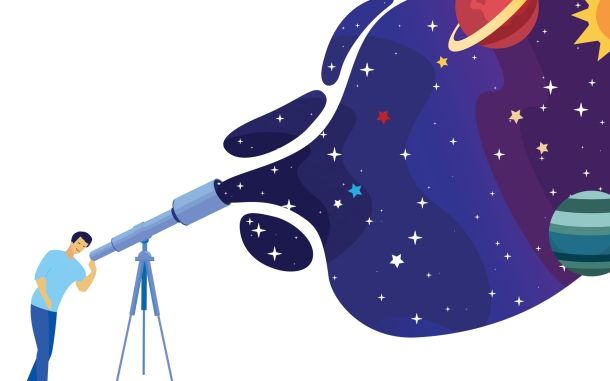Science Square (Issue 156)

In This Article
-
8000 steps a day keep the doctor away
-
Rats may have an imagination too
-
The remains of an ancient planet Theia lie deep within Earth
8000 steps a day keep the doctor away
Stens NA et al. Relationship of Daily Step Counts to All-Cause Mortality and Cardiovascular Events. Journal of the American College of Cardiology, October 2023.
A recent study has not only determined the optimal number of daily steps to maximize health benefits but has also underscored the advantages of brisk walking. The data showed that for a reduced risk of cardiovascular disease and premature death, around 8,000 steps per day is the target. These 8,000 steps are roughly 6.4 kilometers daily, considering the average human stride length (76 centimeters for men and 67 centimeters for women). The study emphasizes the superiority of brisk walking over a slower pace, particularly in reducing the risk of cardiovascular mortality, where the most significant benefits occur around 7,000 steps. This comprehensive study, based on a systematic review of 12 international studies encompassing over 110,000 participants, finds no discernible gender differences. It also highlights that faster walking is associated with a decreased mortality risk, regardless of the total daily step count. Notably, the method used for tracking steps (smartwatch, wrist-based activity tracker, or smartphone) does not impact the recommended step targets. Researchers insist that increasing the number of steps is never harmful. Even walking as many as 16,000 steps a day can bring additional benefits, although the differences in risk reduction are marginal. The ideal step count should be age-appropriate, with younger individuals setting higher targets compared to older individuals. Ultimately, the study aims to provide clear and easily measurable daily step goals, complementing international physical activity recommendations, which recommend 150-300 minutes of moderate-intensity exercise per week. The convenience of step counting, facilitated by the widespread use of smartphones and smartwatches, makes this approach more accessible for many. This study shows that even modest increases in daily steps can yield substantial health benefits, encouraging those with low levels of physical activity to set modest, achievable, and incremental goals.
Rats may have an imagination too
Lai et al. Volitional activation of remote place representations with a hippocampal brain–machine interface. Science, November 2023.
Humans and animals seem to share the ability to imagine and think beyond their immediate surroundings. In a recent scientific revelation, researchers have discovered that rats, similar to humans, possess the ability to imagine places and objects not physically present. Leveraging a unique combination of virtual reality technology and a brain-machine interface (BMI), scientists have found that rats can generate neural activity patterns associated with specific locations and objects, even in the absence of their physical presence. This ability to imagine distant locations is crucial for the recollection of past events and the conceptualization of potential future scenarios, indicating that animals, like humans, have a form of imagination. The researchers developed a real-time "thought detector" through the BMI, establishing a direct correlation between neural activity and a comprehensive 360-degree VR arena. This framework enabled researchers to effectively measure and decode cognitive processes taking place in the rat's brain.. Beyond highlighting the mental sophistication of animals, this research has the potential to catalyze advancements in the rapidly evolving field of Neuroprosthesis. Neuroprosthesis encompasses the utilization of brain functions to operate and control various technological devices such as artificial limbs, robotic arms, or hearing implants. This study opens up new avenues for exploring the intricacies of animal cognition and its potential implications for the development of cutting-edge neuroscientific technologies.
The remains of an ancient planet Theia lie deep within Earth
Yuan et al. Moon-forming impactor as a source of Earth’s basal mantle anomalies. Nature. November, 2023
In the 1980s, geophysicists made a remarkable discovery deep within the Earth: two colossal, continent-sized structures of mysterious material nestled beneath the African continent and the Pacific Ocean. Known as Large Low-Velocity Provinces (LLVPs), these massive anomalies, each approximately twice the size of the Moon, exhibit elemental compositions distinct from the surrounding mantle. A recent study has put forward a captivating hypothesis, proposing an origin for these perplexing formations. Researchers suggest that the LLVPs are remnants of an ancient planet that violently collided with Earth billions of years ago, coinciding with the monumental impact that birthed the Moon. This study also offers a solution to another long-standing planetary science mystery. While the formation of the Moon following a colossal collision between Earth and a smaller planet named Theia has been widely theorized, no evidence of Theia's existence has ever been discovered in the asteroid belt or meteorites. The new study postulates that a substantial portion of Theia was absorbed into a young Earth, forming the LLVPs, while the remaining debris from the collision coalesced to form the Moon. Simulations suggest that the impact could have led to the formation of both the LLVPs and the Moon. The upper mantle absorbed much of the impact's energy, resulting in Earth's lower mantle being cooler than previously estimated. Consequently, the iron-rich material from Theia endured and settled near the base of the mantle. This finding has implications for understanding Earth's early formation, including processes like plate tectonics. It suggests that the LLVPs have an ancient origin and may have influenced the planet's early development, such as the onset of subduction and the formation of the first continents.







